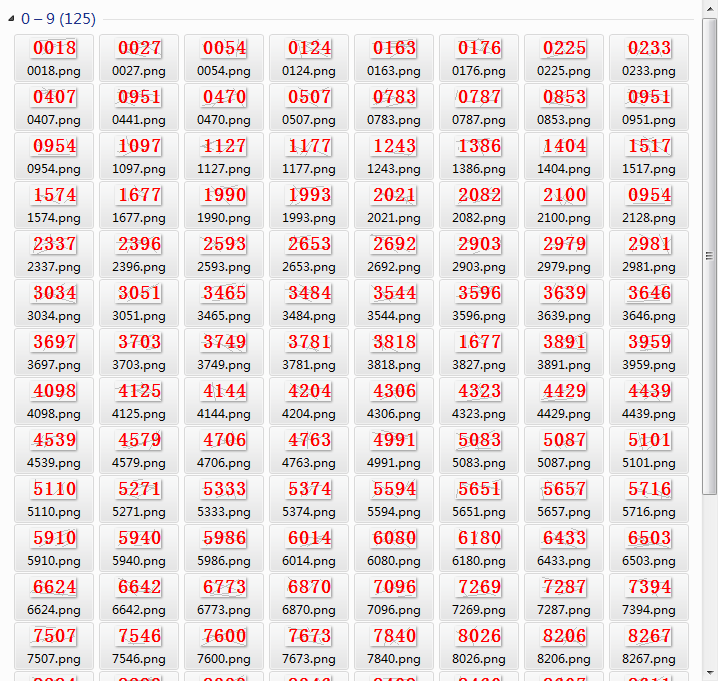python之基于libsvm识别数字验证码
1. 参考
2.图片预处理和手动分类
(1)分析图片
from PIL import Image img = Image.open('nums/ttt.png')
gray = img.convert('L') img.show()
windows图片查看器可以放大像素级别:从左到右,从上到下依次为原图,灰度图,阈值为100的二值图,分割图。

# 输出为(count,(R,G,B,A)) alpha透明度一般为255 In [366]: sorted(img.getcolors()) (22, (251, 0, 0, 255)), (24, (251, 184, 245, 255)), (41, (192, 192, 192, 255)), #没有交叉的灰色干扰线 (102, (255, 0, 0, 255)), #红色数字 (490, (245, 245, 245, 255))] #背景色白色 # img.convert帮助显示 L = R * 299/1000 + G * 587/1000 + B * 114/1000 # 所以可以确定干扰线灰色RGB 192 192 192的灰度为192 In [367]: sorted(gray.getcolors()) (24, 210), (41, 75), (41, 192), (102, 76), (505, 245)] # 按照灰度排序,基本确定阈值为100以下全黑 In [369]: sorted(gray.getcolors(),key=lambda x:x[1]) [(1, 70), (2, 73), (41, 75), (102, 76), (2, 82), (11, 83), (10, 88), (5, 98), # getdata也可以查看数据 In [371]: list(img.getdata()) Out[371]: [(245, 245, 245, 255),
(2)批量下载图片
# 批量下载100张验证码 # urllib.urlretrieve(url,'nums/ttt.png') #也行,不支持https # 如 urls='https://bytebucket.org/wswp/code/raw/9e6b82b47087c2ada0e9fdf4f5e037e151975f0f/chapter07/samples/sample1.png' # http://blog.csdn.net/zyz511919766/article/details/25049365 # python内置的urllib模块不支持https协议的解决办法 # 编译安装python之前没有编译安装类似于openssl这样的SSL库,以至于python不支持SSL # [Errno socket error] [SSL: UNKNOWN_PROTOCOL] unknown protocol (_ssl.c:590) url='http://jbywcg.lnypcg.com.cn/CommonPage/Code.aspx?0.10330188674268' #后面添加任意数字即可 for i in range(100): with open('nums/%s.png'%i,'wb') as f: f.write(urllib2.urlopen(url+str(i)).read()) # 新建分类文件夹,0~9 for i in range(10): os.mkdir('nums/%s'%i)
(3)对100张验证码进行预处理,数字分割,然后手动分类并保存到相应文件夹
import time for index in range(100): img = Image.open('nums/%s.png'%index) gray = img.convert('L') gray_array = np.array(gray) # 阈值100以下黑色标记为1,方便确定边缘 bilevel_array = np.where(gray_array<100,1,0)
left_list = []
# 从左到右按列求和 vertical = bilevel_array.sum(0) # 验证码图片规律:左右留白,上下留白3和4,每个数字占据w8h13,总共4个数字 # 从左到右按列扫描,2白1黑确定为数字左边缘 for i,c in enumerate(vertical[:-2]): if vertical[i] == 0 and vertical[i+1] == 0 and vertical[i+2] != 0: left_list.append(i+2) if len(left_list) == 4: break
# 分割为肉眼可分辨的图片 bilevel = Image.fromarray(np.where(gray_array<100,0,255)) children = [bilevel.crop((left,3,left+8,img.height-4)) for left in left_list] for child in children: child.show() result = raw_input(':') child.save('nums/%s/%s_%s.png'%(result,result,time.strftime('%H%M%S'))) print index
(4)确认分类结果
# 分割图片尺寸太小w8h13,windows看图软件显示为小黑块,img.show()则正常 # 将所有分割图片按行排列合并一图
import os
# 确定新建图片最大宽度 count_max = max(len(os.listdir('nums/%s'%i)) for i in range(10)) img_merge = Image.new('1',(8*count_max,13*10)) for h in range(10): for w,f in enumerate(os.listdir('nums/%s'%h)): img_merge.paste(Image.open('nums/%s/%s'%(h,f)),(w*8,h*13)) img_merge.show()
3.libsvm训练
# 1.官网页面搜索download下载压缩包 http://www.csie.ntu.edu.tw/~cjlin/libsvm/#download
# 2.将压缩包所有文件解压到 Lib\site-packages\libsvm
# 3.将 libsvm\windows 的 libsvm.dll 复制到 C:\WINDOWS\system32\ http://blog.csdn.net/yearningseeker/article/details/49018015
# 4.在 libsvm 根目录和 libsvm\python 子目录下中分别新建名为__init__.py的空文件即可 http://www.cnblogs.com/Finley/p/5329417.html
def get_feature(num, picpath): img = Image.open(picpath) # 纯黑白转为01二值 img_array = np.array(img)/255 # 先遍历w,再遍历h,8+13总共21维度 # 这里以每一维上的0个数为特征值,img_array.shape[0]是总行数 return (num, list(img_array.shape[0]-img_array.sum(0)) + list(img_array.shape[1]-img_array.sum(1))) def write_features(feature_list, filepath='nums/result_temp.txt'): with open(filepath,'w') as fp: # LIBSVM 对样本文件的格式要求为:<label> <index1>:<value1> <index2>:<value2> ... # 1 1:1 2:2 3:2 4:3 5:4 6:13 7:2 8:2 9:1 10:2 11:2 12:2 13:1 14:2 15:2 16:1 17:8 18:1 19:1 20:1 21:5 for num, data in feature_list: temp = ' '.join([str(num)] + [str(i)+':'+str(j) for (i,j) in zip(range(1,len(data)+1), data)]) fp.write(temp+'\n') # 批量获取0~9十个文件夹所有分割数字的特征值并写入features.txt feature_list = [] for num in range(10): for filename in os.listdir('nums/%s'%num): feature_list.append(get_feature(num, 'nums/%s/%s'%(num,filename))) write_features(feature_list, 'nums/features.txt') from libsvm.python.svmutil import * from libsvm.python.svm import * # 训练得到分类模型model文件 def train_svm_model(): y, x = svm_read_problem('nums/features.txt') model = svm_train(y, x) svm_save_model('nums/model', model)
4.libsvm测试
重复之前批量下载和手动分类得到features_test.txt,测试正确率。
def svm_model_test(filepath='nums/features_test.txt'): yt, xt = svm_read_problem(filepath) model = svm_load_model('nums/model') p_label, p_acc, p_val = svm_predict(yt, xt, model)#p_label即为识别的结果 return ''.join(str(int(p)) for p in p_label)
5.完整应用
#!/usr/bin/env python #coding: UTF-8 import os, time import urllib, urllib2 from PIL import Image import numpy as np from libsvm.python.svmutil import * from libsvm.python.svm import * def get_image(url=''): url='http://jbywcg.lnypcg.com.cn/CommonPage/Code.aspx?0.10330188674268' temp = time.strftime('%H%M%S') picpath = 'nums/temp/%s.png'%(temp) with open(picpath,'wb') as f: f.write(urllib2.urlopen(url+str(temp)).read()) return picpath def split_image(filepath): img = Image.open(filepath) # img.show() gray = img.convert('L') gray_array = np.array(gray) bilevel_array = np.where(gray_array<100,1,0) left_list = [] vertical = bilevel_array.sum(0) for i,c in enumerate(vertical[:-2]): if vertical[i] == 0 and vertical[i+1] == 0 and vertical[i+2] != 0: left_list.append(i+2) if len(left_list) == 4: break bilevel = Image.fromarray(np.where(gray_array<100,0,255)) children = [bilevel.crop((left,3,left+8,img.height-4)) for left in left_list] filepath_list = [] for i,child in enumerate(children): filepath = 'nums/temp/%s_%s.png'%(time.strftime('%H%M%S'),i+1) filepath_list.append(filepath) child.save(filepath) return filepath_list def get_feature(num, picpath): img = Image.open(picpath) img_array = np.array(img)/255 #先遍历w,再遍历h return (num, list(img_array.shape[0]-img_array.sum(0)) + list(img_array.shape[1]-img_array.sum(1))) def write_features(feature_list, filepath='nums/features_test.txt'): with open(filepath,'w') as fp: for num, data in feature_list: temp = ' '.join([str(num)] + [str(i)+':'+str(j) for (i,j) in zip(range(1,len(data)+1), data)]) fp.write(temp+'\n') def svm_model_test(filepath='nums/features_test.txt'): yt, xt = svm_read_problem(filepath) model = svm_load_model('nums/model') p_label, p_acc, p_val = svm_predict(yt, xt, model) #p_label即为识别的结果 return ''.join(str(int(p)) for p in p_label) def main(): while True: picpath = get_image() splitpath_list = split_image(picpath) feature_list = [] for splitpath in splitpath_list: feature_list.append(get_feature(1, splitpath)) #1为任意预设整数值 os.remove(splitpath) write_features(feature_list) result = svm_model_test() print result (dirname, filename) = os.path.split(picpath) (shortname, extension) = os.path.splitext(picpath) try: os.rename(picpath, os.path.join(dirname,result+extension)) except: os.rename(picpath, os.path.join(dirname,result+'_'+time.strftime('%H%M%S')+extension)) if __name__ == '__main__': main()
6.运行结果




